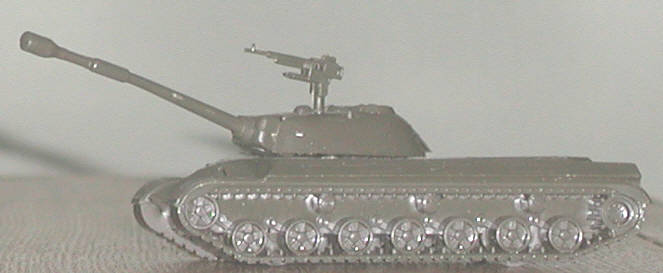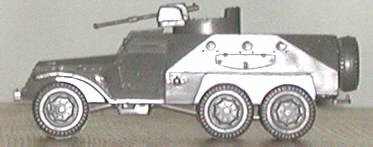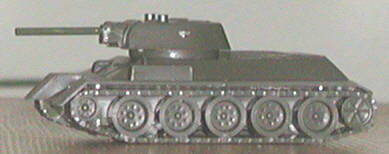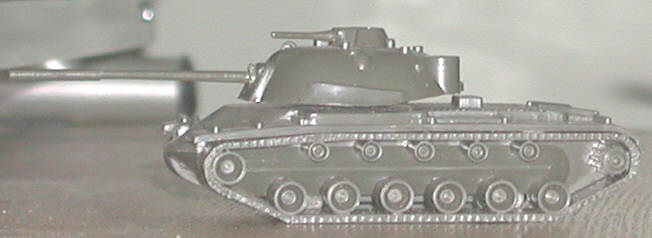Copyright 2012 T. Sheil & A. Sheil All Rights Reserved
Army Men Homepage
Roskopf
1/100 Scale Miniature Tanks
I first came across the Roskopf Tanks in 1970. They were a shade smaller than ROCO minitanks and had less detail. The advantage they had was a full assortment of Soviet and Warsaw Pact armor. Nobody else had so much. ROCO had the JS III and T34 and perhaps the T54 / T55. Airfix had the JSIII and T34, too. Roskopf had everything else. For kids playing crude miniature wargames, scale compatibility was less important that having the piece in question. Even scale modelers were known to capitulate. In the 1970s, Military Modeler magazine was known to show dioramas blending 1/32 and 1/35 models and made no excuse for them. Why quibble for the smaller scales?
Roskopf made the KV tanks, the IS self-propelled guns and an assortment of Cold War vehicles. At the time, many were front-line vehicles in use by the Warsaw pact. BTR40s. BRDMs, T55s, BTR152 wheeled armored cars and other contemporary vehicles were available, and we were glad to buy them. If ROCO did not make it, there was a good chance Roskopf did.
I had a lot of fun with the KV tanks and SP guns. We would paint them, weather them heavily, and even try to copy the Russian slogans painted on the turrets. None of us knew a thing about the Cyrillic alphabet, but according to a Ukrainian fellow, we did a decent job copying it. Roskopf tanks were a lead-in to our reading more on the Soviet side of World War II. It also gave us a jump on the then-current Warsaw Pact inventory. The PT76s, BTR60s and T62s were among the opposing arsenal when I was in the Army.
The Roskopf tanks were among the pieces lost when my collection was gone after a disastrous move in the mid-1980s. I have acquired some on the Internet, mainly the KVs. Unfortunately, the company is no longer in business and nobody has reissued the military vehicles.
The KV Tanks
ROCO and Airfix both had models of the ubiquitous Soviet T34 tanks and the 'Josef Stalin' JS3 Heavy Tank. The T34 proved to be the workhorse of the Soviet tank force. The JSIII arrived a little to late for World War II and only saw action in the Arab armies of the Cold War era. The heavy tank that served the Soviets for most of World War II was the KV series. Named for a Soviet named Klementi Voroshilov, the KV gave the Germans quite a nightmare. Their tank guns could not match this heavily-armored beast, and its 76mm gun could handle anything in the German tank inventory of 1941 and early 1942. Germany upgunned and the Russians up-armored the KV.
To provide close artillery support in the assault gun role, the Russians cooked up the KV 2. This tank had a massive turret to house a 152mm howitzer. It was bulky and clumsy and did not perform as well as expected. The Russians also upgunned their KV1 in 1943 by producing a new turret with the more powerful 85mm gun. The KV 85 held the line and provided the first stage toward evolution of the JS series. In fact, the JS1 and JSII were little more than upgunnsd KVs with improved armor and a slightly modified hull.
We loved the Roskopf KVs for our games. Granted they were smaller in scale than the Roco and Airfix T34s and it showed. We were glad to have them.
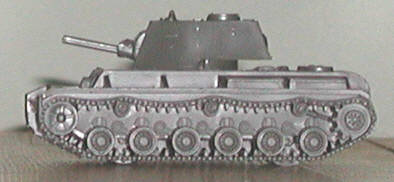
KV1 with its 76mm gun. A "no frills" heavy tank | 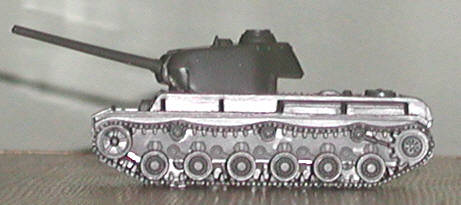
The heaver gun and improved armor made the KV85 a more formidable battle wagon. |
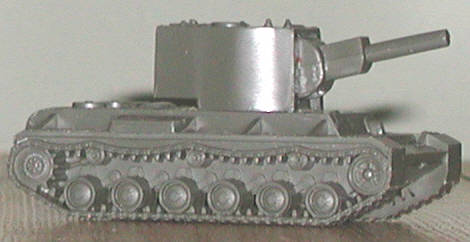
The KV2 had the usual klunky look one associates with anything Russian. It is little more than an assault gun. | 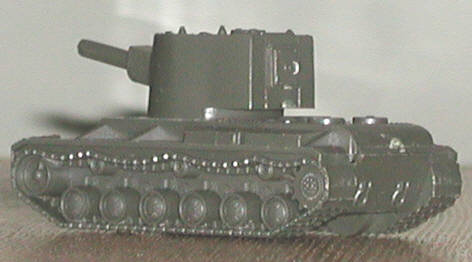
From the rear, yo ucan see where the machine gun would be mounted in back of the turret. The KV2 was a beast. |
| |
The T-10
The Soviets replaced the JSIII with an improved heavy tank, the T10. These saw action in the Middle East. Though they withstood a frontal attack at long range from the US 90mm gun, their slow speed and weaker side armor negated any advantage. Having the T-10 was a plus for us when doing Cold War games.
BTRs - Soviet Personnel Carriers
Roskopf made an assortment of these small armored cars. There were personnel carrier versions ,a command car and anti-aircraft vehilce with twin AA guns. Several Soviet clients produced their own versions of the BTR 152, such as the Walid used by Arab countries
T34
The T34 was quite a surprise ot the Germans. At the time they first encoutnered it, the T34 had better armor, a more powerful and and great cross-country ability. The Germans quickly pressed various tank destroyers into service while the factories upgunned their tanks. Better training, a better quality of manufacture and better command and control prevented a disaster. The T34 with 76mm gun was the mainstay of Russian forces until they produced a version with an 85mm gun. The T34/85 remained in Soviet service for many years. It was exported to Warsaw Pact countries and Soviet clients. Some were still in service at the end of the 20th century in a few Third World countries.
PT76 and Light Tanks
Postwar Soviet tank development included a variety of small, fast, light vehicles such as the BTR 40 / BRDM. The PT76 was a light tank that also had an amphibious capability.Its main armament was a 76mm smoothbore weapon that fired HEAT rounds. I had the chance to inspect one of these tanks up close. The sides seemed hardly bulletproof, and its diesel engine made a huge cloud of smoke. As tanks go, a typical Russian death trap.
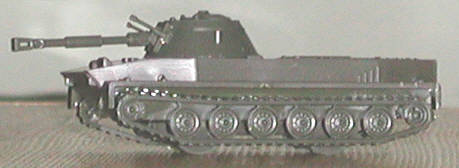 | |

In reality the T34 is taller and longer than the PT76 | |
The M48
Cold War American Main Battle tank
The M48 was the main battle tank for the US and many of its clients during the Cold War Era. Earlyer version was armed with the 90mm gun. The last version had a 105mm fgun. Many were urgraded to the 105mm standard in the 1970s. The M48 performed well invarious conflicts for the US and its allies. Roskopf's model of the M48 was identical to the first version made by ROCO and to the copy by EKO. The model is actually slightly larger than the Roskopf T10, which is odd since the T10 was a larger, heavy tank. Roskopf, ROCO and EKO had their problems with scale consistency.
Jagdpanzer
(Cold War Era)
The armored tank destroyer concept provided Germany with a stop-gap antitank weapon when the T34 and KV1 appeared. The concept was still alive in the 1960s. Germany, the Soviets and Sweden had invested in turretless tank destroyers such as the SU122, the Swedish "S" tank and the German Jagdpanzer. Armed with a 90mm gun and a very low superstructure with thick frontal armor, the Jagdpanzer was a modern example of an outdated concept.
The Roskopf version of the Jagdpanzer was notably smaller than the 1/87 Roco version.
Modern US Self-Propelled Guns
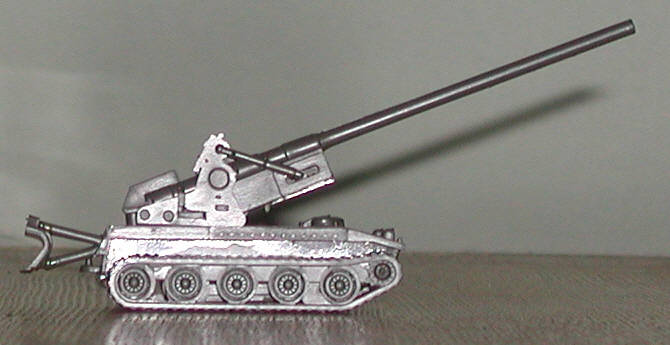
175mm Self-propelled gun. This weapon had an amazing range. The same chassis was used for the 8 inch gun. | |
| |
| |
Armored Cars
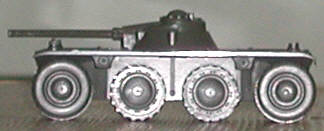
French Panhard EBR 75 with FL11 turret. The gun was almost identical to that of the Panther Tank. | |
| |
| |
| |
Click here to return to the main page





